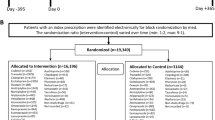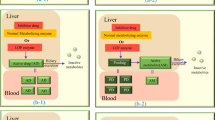Abstract
Despite the recognition that drug–drug interactions contribute substantially to preventable health-care costs, the prevalence of such interactions related to the cytochrome P450 system in clinical practice remains poorly characterized. This study drew retrospective hospital discharge cohorts from a large health claims data set and a large health system data set. For every hospital discharge, frequency of co-occurrence of substrates and inducers or inhibitors at cytochrome P450 2D6, 2C19, 3A4 and 1A2 were determined. A total of 124 520 individuals in the state of Massachusetts (health claims cohort) and 77 026 individuals in two large academic medical centers (electronic health record (EHR) cohort) were examined. In the claims cohort, 35 157 (28.2%) exhibited at least one CYP450 drug–drug interaction at hospital discharge, whereas in the EHR cohort, 36 750 (47.7%) had at least one interaction. The most commonly affected CYP450 systems were 2C19 and 2D6, with putative interactions observed in at least 10% of individuals at discharge in each cohort. Odds of hospital readmission within 90 days among those discharged with at least one interaction were 10–16% greater, with mean health-care cost $574/month greater over the subsequent year, after adjusting for age, sex, insurance type, total number of medications prescribed, Charlson comorbidity score and presence or absence of a psychiatric diagnosis. These two distinct clinical data types show that CYP450 drug–drug interactions are prevalent and associated with greater probability of early hospital readmission and greater health-care cost, despite the widespread availability and application of drug–drug interaction checking software.
This is a preview of subscription content, access via your institution
Access options
Subscribe to this journal
Receive 6 print issues and online access
$259.00 per year
only $43.17 per issue
Buy this article
- Purchase on Springer Link
- Instant access to full article PDF
Prices may be subject to local taxes which are calculated during checkout

Similar content being viewed by others
References
Jankel CA . FL. Epidemiology of drug-drug interactions as a cause of hospital admissions. Drug Saf 1993; 9: 51–59.
Ostermann JK, Berghöfer A, Andersohn F, Fischer F . Frequency and clinical relevance of potential cytochrome P450 drug interactions in a psychiatric patient population–an analysis based on German insurance claims data. BMC Health Serv Res 2016; 16: 482.
Simpao AF AL, Desai BR, Bonafide CP, Galvez JA, Rehman MA, Jawad AF et al. Optimization of drug-drug interaction alert rules in a pediatric hospital's electronic health record system using a visual analytics dashboard. J Am Med Inform Assoc 2014; 22: 361–369.
Yeh ML CY, Wang PY, Li YC, Hsu CY . Physicians' responses to computerized drug-drug interaction alerts for outpatients. Comput Methods Programs Biomed 2013; 111: 17–25.
Taegtmeyer AB, Kullak-Ublick GA, Widmer N, Falk V, Jetter A . Clinical usefulness of electronic drug-drug interaction checking in the care of cardiovascular surgery inpatients. Cardiology 2012; 123: 219–222.
van Leeuwen RW JF, van den Bemt PM, de Man F, Piran F, Vincenten I, Jager A et al. Drug-drug interactions in patients treated for cancer: a prospective study on clinical interventions. Ann Oncol 2015; 26: 992–997.
van Leeuwen RW BD, Neef C, van Gelder T, Mathijssen RH, Burger DM, Jansman FG . Prevalence of potential drug-drug interactions in cancer patients treated with oral anticancer drugs. Br J Cancer 2013; 108: 1071–1078.
Ellis JJ SA, Ten Eyck LL, Cappelleri JC, Brown CR, Suehs BT, Parsons B . Impact of potential pregabalin or duloxetine drug-drug interactions on health care costs and utilization among Medicare members with fibromyalgia. Clinicoecon Outcomes Res 2014; 6: 389–399.
Teklay GSN, Legesse B, Bekele ML . Drug-drug interactions and risk of bleeding among inpatients on warfarin therapy: a prospective observational study. Thromb J 2014; 12: 20.
Patel NNM, Koroglu A, Bliss S, Davis M, McNutt LA, Miller C . A cross-sectional study comparing the frequency of drug interactions after adding simeprevir- or sofosbuvir-containing therapy to medication profiles of hepatitis C monoinfected patients. Infect Dis Ther 2015.
Doan J Z-JH, Roy J, Turgeon J, Tannenbaum C . Prevalence and risk of potential cytochrome P450-mediated drug-drug interactions in older hospitalized patients with polypharmacy. Ann Pharmacother 2013; 47: 324–332.
Secoli SR FA, Lebrão ML, de Lima FD, Santos JL . Risk of potential drug-drug interactions among Brazilian elderly: a population-based, cross-sectional study. Drugs Aging 2010; 27: 759–770.
Tulner LR, Frankfort SV, Gijsen GJ, Campen JPv, Koks CH, Beijnen JH . Drug-drug interactions in a geriatric outpatient cohort. Drugs Aging 2008; 25: 343–355.
Wong KYS, Holbrook A . A systematic review of medication safety outcomes related to drug interaction software. J Popul Ther Clin Pharmacol 2010; 17: e243–e255.
Zhou SF LJ, Chowbay B . Polymorphism of human cytochrome P450 enzymes and its clinical impact. Drug Metab Rev 2009; 41: 89–295.
Wang L, McLeod HL, Weinshilboum RM . Genomics and drug response. N Engl J Med 2011; 364: 1144.
Massachusetts All Payer Claims Database. Center for Health Information and Analysis (CHIA); (cited 2015); available from http://chiamass.gov/ma-apcd/.
Castro VM, McCoy TH, Cagan A, Rosenfield HR, Murphy SN, Churchill SE et al. Stratification of risk for hospital admissions for injury related to fall: cohort study. BMJ 2014; 349: g5863.
Perlis RH, Iosifescu DV, Castro VM, Murphy SN, Gainer VS, Minnier J et al. Using electronic medical records to enable large-scale studies in psychiatry: treatment resistant depression as a model. Psychol Med 2012; 42: 41–50.
Clements CC, Castro VM, Blumenthal SR, Rosenfield HR, Murphy SN, Fava M et al. Prenatal antidepressant exposure is associated with risk for attention-deficit hyperactivity disorder but not autism spectrum disorder in a large health system. Mol Psychiatry 2014; 20: 727–734.
Murphy SN, Mendis M, Hackett K, Kuttan R, Pan W, Phillips LC et al. Architecture of the open-source clinical research chart from Informatics for Integrating Biology and the Bedside. AMIA Annu Symp Proc 2007; 11: 548–552.
Indiana University Department of Medicine. Flockhart Table: P450 Drug Interaction Table. 2016 (February 2016); available from http://medicine.iupui.edu/clinpharm/ddis/main-table/.
Healthcare Cost and Utilization Project (HCUP). Clinical Classifications Software (CCS) for ICD-9-CM. Agency for Healthcare Research and Quality, Rockville, MD; 2016 (March 2016); available from https://www.hcup-us.ahrq.gov/toolssoftware/ccs/ccs.jsp#pubs.
Juurlink DN MM, Kopp A, Laupacis A, Redelmeier DA . Drug-drug interactions among elderly patients hospitalized for drug toxicity. JAMA 2003; 289: 1652–1658.
Pergolizzi JV Jr, Labhsetwar SA, Amy Puenpatom R, Ben-Joseph R, Ohsfeldt R, Summers KH . Economic impact of potential CYP450 pharmacokinetic drug-drug interactions among chronic low back pain patients taking opioids. Pain Pract 2012; 12: 45–56.
Malone DC HD, Haupert H, Hansten P, Duncan B, Van Bergen RC, Solomon SL et al. Assessment of potential drug-drug interactions with a prescription claims database. Am J Health Syst Pharm 2005; 62: 1983–1991.
Grizzle AJ, Mahmood MH, Ko Y, Murphy JE, Armstrong EP, Skrepnek GH et al. Reasons provided by prescribers when overriding drug-drug interaction alerts. Am J Manag Care 2007; 13: 573–578.
Van Der Sijs H, Aarts J, Vulto A, Berg M . Overriding of drug safety alerts in computerized physician order entry. J Am Med Inform Assoc 2006; 13: 138–147.
Author information
Authors and Affiliations
Corresponding author
Ethics declarations
Competing interests
All authors have completed the Unified Competing Interest form at www.icmje.org/coi_disclosure.pdf (available on request from the corresponding author). RHP has served on advisory boards or provided consulting to Genomind, Healthrageous, Perfect Health, Pfizer, Psybrain and RIDVentures. VMC, AR, AC, THM and LS declare no conflict of interest.
Additional information
Author contributions
VMC and AC cleaned and formatted the data set, generated variables for analysis and contributed to the interpretation of results and manuscript preparation. AR and LS contributed to preparation of the manuscript. THM developed algorithms for parsing medication lists based on cytochrome P450 status, contributed to study design and helped to draft the manuscript. RHP initiated the project, designed the study, conducted the analyses and helped to draft the manuscript. He is a guarantor. All authors had full access to all of the data (including statistical reports and tables) in the study and can take responsibility for the integrity of the data and the accuracy of the data analysis. RHP affirms that this manuscript is an honest, accurate and transparent account of the study being reported; that no important aspects of the study have been omitted; and that any discrepancies from the study have been explained.
PowerPoint slides
Rights and permissions
About this article
Cite this article
McCoy, T., Castro, V., Cagan, A. et al. Cytochrome P450 interactions are common and consequential in Massachusetts hospital discharges. Pharmacogenomics J 18, 347–350 (2018). https://doi.org/10.1038/tpj.2017.30
Received:
Revised:
Accepted:
Published:
Issue Date:
DOI: https://doi.org/10.1038/tpj.2017.30



